#Jerusalem studio school
Explore tagged Tumblr posts
Text
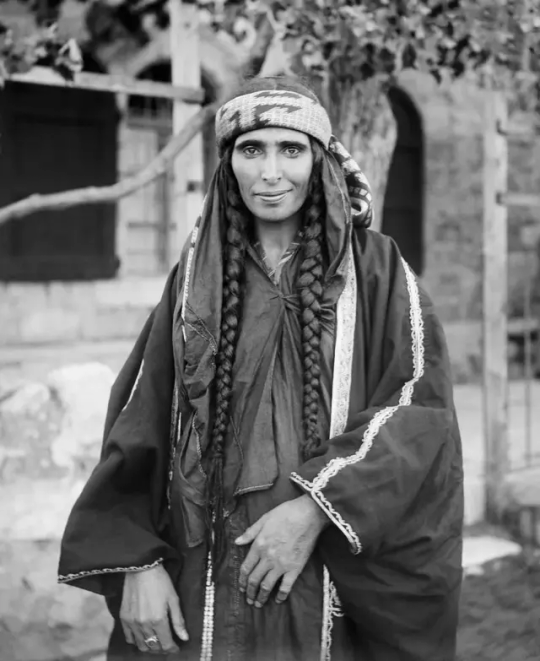
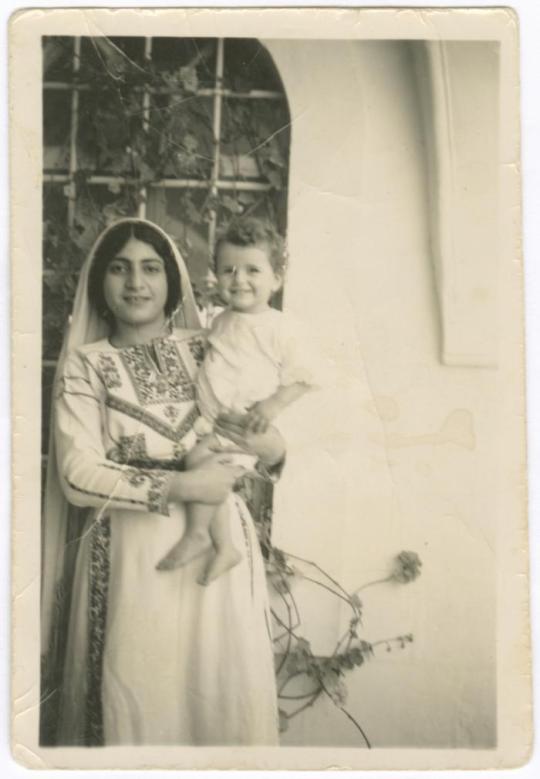


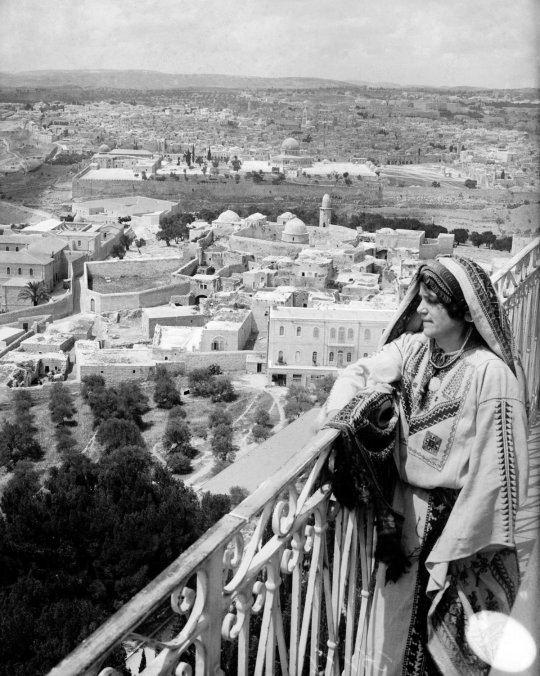


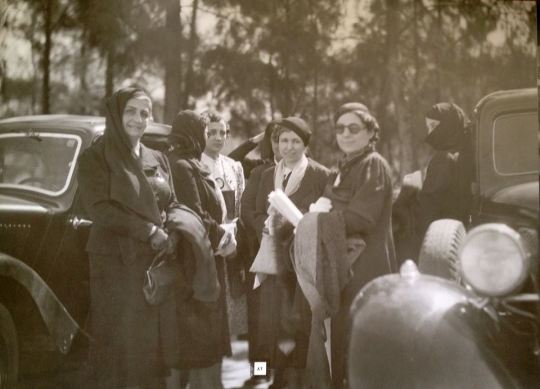
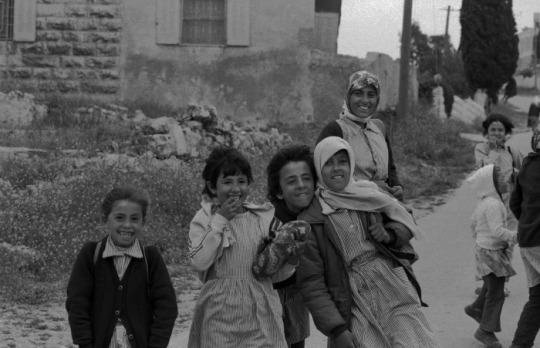

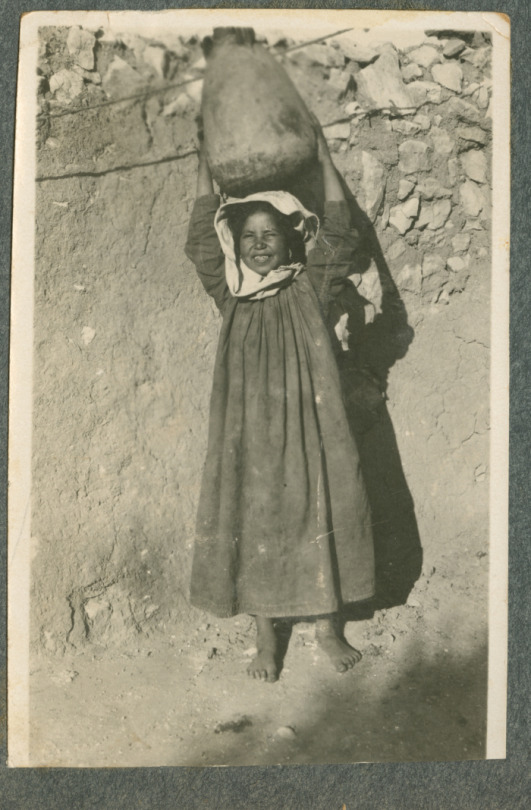

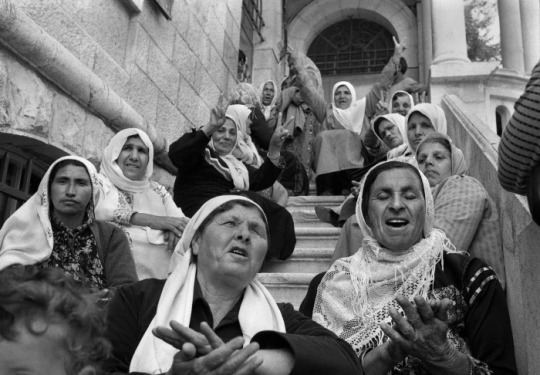
Moments from Palestine across generations and communities
(1) A Bedouin woman smiles in Jerusalem (1898-1914)
(2) Asma Aranki Holding a Child from Her Family at Their House, Birzeit (1948)
(3) Bedouin girls in Jericho (1918)
(4) An extended Palestinian family gathers in front of their house in the village of Beit Sahur, near Bethlehem (1918–35)
(5) From the Mount of Olives, a young woman looks out over eastern Jerusalem (1929)
(6) Ruth Raad, daughter of photographer Khalil Raad, in the traditional costume of Ramallah (1939)
(7) Standing in his neatly ironed shirt and shorts, George Sawabin poses for a studio photo (1942)
(8) Katingo Hanania Deeb, prepares to demonstrate in the 1936-1939 Arab Revolt -- which was a nationalist uprising by Palestinian Arabs against British colonial rule in relation to Palestinian independence and the land acquisition and pushout as a result of the mass Jewish immigration (1936)
(9) Young children walking home from school Beit Deqqo Village, the Occupied Palestinian West Bank, 1987
(10) Four young girls decorating vases in a ceramic workshop in Nablus (1920)
(11) A young Palestinian girl squints and smiles as she holds a jar on her head (1920-1950)
(12) The ancient craft of a Palestinian potter (1918-35)
(13) The mothers of Palestinian detainees' protest in Jerusalem (1987)
Source(s): The British Mandate Jerusalemites (BMJ) Photo Library, Palestinian Museum Digital Archives, The Jerusalem Story + Khalil Raad
Please support, share, cite, and (if financially able) fund these organizations and public storytellers for their rebellious histories and community work!
#decolonization#our world#our history is your history#people#free palestine#palestine#indigenous rights#art of making#and manifesting#history is not neutral#futurepast
4K notes
·
View notes
Text
A Palestinian man is asked in an interview by a white woman if he condemns Hamas while his people are being slaughtered in the open, and HE is the one condemned when he yells that it's injustice to insulate that his people deserve to be murdered, because "Hamas chose this."
A black woman is attacked first in a fight and SHE is the bad guy when she strikes back, she is the one whose face is plastered all over social media to be condemned and shamed for "aggression."
Two sisters are appropriately reacting to their oppressors by ripping off posters promoting their propaganda, and THEY are shamed and attacked for their lack of politeness when their people are being killed for existing.
An American democrat watches her colleagues cheer on genocide and ethical cleansing, the murder of children and the rape of women and the slaughter of families, and SHE is the one censored for speaking out in defense of them, despite her grief of losing family members.
Zionists are not condemned for enjoying the thought of children being killed, for calling Palestinians "animals" or saying Gaza should be "turned into a parking lot", Israeli doctors can get away with demanding that Palestinians, HUMAN BEINGS, should be murdered, that their only remaining hospital should be crushed.
They are not condemned for saying they wanted nuclear weapons unleashed on Gaza, they are not condemned for the imprisonment and torture of children, for desecrating dead Palestinians' corpses and mauling their bodies, for mocking Muslim Palestinians by rubbing their bullets against pig's skin before shooting them, for bombing Palestinian churches, for bombing universities, for shutting electricity from Gaza, cutting Palestinians from food and water, not letting them access to aid, for bombing CANCER hospitals and CHILDRENS HOSPITALS, for turning the sky of Gaza RED from explosions, for killing enough students that the entire school year was canceled, for annihilating families, for attacking Jewish people in Jerusalem, for cutting dead fetuses off dead mothers, for STEALING THEIR SKIN AND ORGANS and using them for their benefit, for forcing CHILDREN to hold a press conference to say that hey, they want to live.
Insinuating that this is about religion is the basis of Zionism. 60 members of Hamas were killed, and 10,500 civilians killed, 4000 of which are children. Over 800 bloodlines erased. Israel says they aim for "damage, not accuracy." Implying this is about Hamas is lies.
When white people in power tell you from their air-conditioned studios this is Israel defending itself, refuse to let Palestinian journalists explain things happening from their point of view, watch those journalists lose their entire families for speaking about what's happening to them, demonize Arabs who rage about injustice, ask Palestinians grieving if they condemn Hamas, know this is propaganda.
You shouldn't need them to tell you they're parroting lies to you. Their lies kill people. Their lies destroy people. Their apologies are insincere and their "sympathy" is limited only to those who look like them. It is unjust. It is cruel.
If I was were to narrate to you every atrocity Israel commited that I am aware of, I would never stop typing.
#and no matter how much people will yell about this#zionists will only listen to other zionists#no matter how brilliant and educated a non-white person#can be#their opinions and thoughts are disregarded#cnn only aired an interview from a nurse working at the Indonesian hospital in gaza because she was white#no matter how many people yell for the world to free Palestinians#how many humans with heart and grace do so#the congress and biden are the ones with power.#listen to people and be patient#we should not quiet down once a ceasefire is called.#we should keep yelling until every man and woman and child and tree and house in Palestine is free#until the birds chirp again without being shot down.#palestine#free palestine
360 notes
·
View notes
Text
Greer Garson - The Duchess












Eileen Evelyn Greer Garson (born in Manor Park, Essex on September 29, 1904) was a British-American actress. Her air of controlled maturity and understated elegance lent to her being referred to as "The Duchess."
She graduated with a B.A. with honors in English in 1926 at King's College London and did postgraduate work and studied French theater at the University of Grenoble in 1927. Starting out later as an actress, her early professional appearances were on stage, starting at Birmingham Repertory Theatre.
Louis B. Mayer discovered Garson while in London looking for new talent. In 1937, Garson signed with MGM, where she became a major box-office star. Her portrayal of strong women brought her critical acclaim, earning Oscar nods in films such as Mrs. Miniver (1942) and The Valley of Decision (1945).
She only made a few films after her contract expired, but continued to appear on television. In 1967, she retired at Forked Lightning Ranch in New Mexico and focused on philanthropic interests.
She lived her final years in a penthouse suite at the Texas Health Presbyterian Hospital in Dallas, where she died from heart failure at 91.
Legacy:
Is the fourth most-nominated woman for the Best Actress Oscar, with seven, including a record-tying five consecutive nominations (1941–1945)
Won the Academy Awards: Best Actress for Mrs. Miniver (1942)
Won the Golden Globe Best Actress for Sunrise at Campobello (1960)
Awarded Best Acting by the National Board Review for Pride and Prejudice (1940), Mrs. Miniver (1942), and Sunrise at Campobello (1960)
Listed by the Motion Picture Herald as one of America's top-10 box office draws from 1942 to 1946
Won Best Actress for Random Harvest (1941) from the 1944 Picturegoer Awards
Awarded Most Popular Female Star by Photoplay Awards in 1945 and 1946
Honored with the Neiman Marcus Fashion Award in 1961
Donated land and money to the Department of the Interior to protect ruins in 1966
Awarded the Golden Gavel by Toastmasters International
Honored as one of the Woman of the Year by the Los Angeles Times in 1968
Received an honorary degree from the Cleveland Institute of Music in 1973
Presented by the American-Scottish Foundation with the William Wallace Award in 1977
Granted an honorary doctorate in 1977 from Ulster University for her endowments of the Greer Garson Film Award and Gree Garson Theatre Award
Established the Greer Garson Theatre Center in 1985 and Greer Garson Communications Center and Studios in 1989 in Santa Fe
Awarded the Conservation Service Award by the Department of Interior in 1981
Set up the endowment for the E. E. Fogelson and Greer Garson Fogelson Distinguished Chair in Urology at the University of Texas Southwestern Medical School and the Greer Garson and E.E. Fogelson Distinguished Chair in Medical Research at the University of Texas Southwestern Medical Center in 1982
Funded the E. E. Fogelson Visitor Center at Pecos National Historical Park in 1987
Honored with an Award for Excellence and Achievement in the Arts by the Governor of New Mexico in 1987
Received the Golda Meir Fellowship Award of the Hebrew University of Jerusalem in 1988
Set up the Fogelson Forum at Texas Christian University in 1990
Received an honorary doctorate and the Medal of Distinction from SMU Meadow School of the Arts in 1991
Presented with the TACA Silver Cup Award in 1991
Has been the namesake for the Texas Health Presbyterian's annual fundraising event, the Greer Garson Gala, since 1992
Established the Greer Garson Theatre at the Southern Methodist University Meadow School of the Arts in 1992
Appointed by Queen Elizabeth II as Commander of the Order of the British Empire (CBE) in 1993
Set up the E.E. Fogelson and Greer Garson Fogelson Charitable Foundation in 1996, with numerous philanthropic interests in the arts, education, environment, and medicine
Donated personal memorabilia as part of the Greer Garson Collection in the SMU Bywaters archival collection
Honored as Turner Classic Movies Star of the Month for March 2013
Inducted in the Online Film and Television Association Hall of Fame in 2014
Has a star on the Hollywood Walk of Fame at 1651 Vine Street for motion picture

#Greer Garson#Mrs. Miniver#The Duchess#Silent Films#Silent Movies#Silent Era#Silent Film Stars#Golden Age of Hollywood#Classic Hollywood#Film Classics#Classic Films#Old Hollywood#Vintage Hollywood#Hollywood#Movie Star#Hollywood Walk of Fame#Walk of Fame#Movie Legends#Actress#hollywood actresses#hollywood icons#hollywood legend#movie stars#1900s
2 notes
·
View notes
Text

A bronze portrait bust of George V by Sydney March, 1911.
The King Emperor is portrayed in his coronation year of 1911 and is shown wearing the robes and insignia of the Order of the Garter, the insignia of the Royal Victorian Order and of the Order of St John of Jerusalem. Signed and dated 1911.Sydney March (1876–1968) was the second of nine children, eight of whom became artists. The March family established their own sculpture studio at Goddendene, Kent, in 1901. Sydney also worked with the art founders Elkington, and was responsible for royal portraits, including Queen Victoria, Queen Alexandra and George V, and for producing figures, busts and statues of leading figures of the day. In the early 1920‘s the March studio was honoured with a visit by members of the Royal Family. Sydney’s public works include statues of Colonel Bevington (Tooley Street, London Bridge, 1911) and Lord Kitchener (Calcutta, 1914; Khartoum, 1921, removed to Royal School of Military Engineering, Chatham, 1958). Among his portrait busts were Cecil Rhodes, Sir John French. March also executed a number of war memorials including Bromley Parish Church (1921) and the United Empire Loyalists Memorial (Hamilton, Ontario, 1929). Following the death of Vernon March in 1930, Sydney and his siblings completed the Canadian National War Memorial at Ottawa.
11 notes
·
View notes
Text
9th March Engagements
The Earl of Wessex
will visit Ashridge House, Berkhamsted, Hertfordshire.
will visit Sky Studios Elstree, Rowley Lane, Borehamwood.
The Countess of Wessex
will visit The Countryside Education Trust, Palace Lane, Beaulieu, Hampshire.
The Princess Royal
as Patron, will visit the Police Treatment Centres, St. Andrews, Harlow Moor Road, Harrogate, North Yorkshire.
Patron, Maritime UK, will attend the Maritime UK Awards Dinner at DoubleTree by Hilton Hull, 24 Ferensway, Hull, East Riding of Yorkshire.
The Duke of Gloucester
Grand Prior, the Most Venerable Order of the Hospital of St John of Jerusalem, will attend a Dinner at St John's Gate, 26 St John's Lane, London.
The Queen Consort
will visit The British Racing School, Snailwell Road, Newmarket, Suffolk, to mark their 40th anniversary.
will visit British Sporting Art Trust, Palace House, Palace Street, Newmarket, Suffolk.
The King
will visit Animal and Plant Health Agency, Woodham Lane, New Haw, Addlestone, Surrey.
The Duchess of Gloucester
Royal Patron, Missing People, will attend a Dinner at Pan Pacific Hotel, 80 Houndsditch, London, EC3, to celebrate their 30th Anniversary.
18 notes
·
View notes
Photo
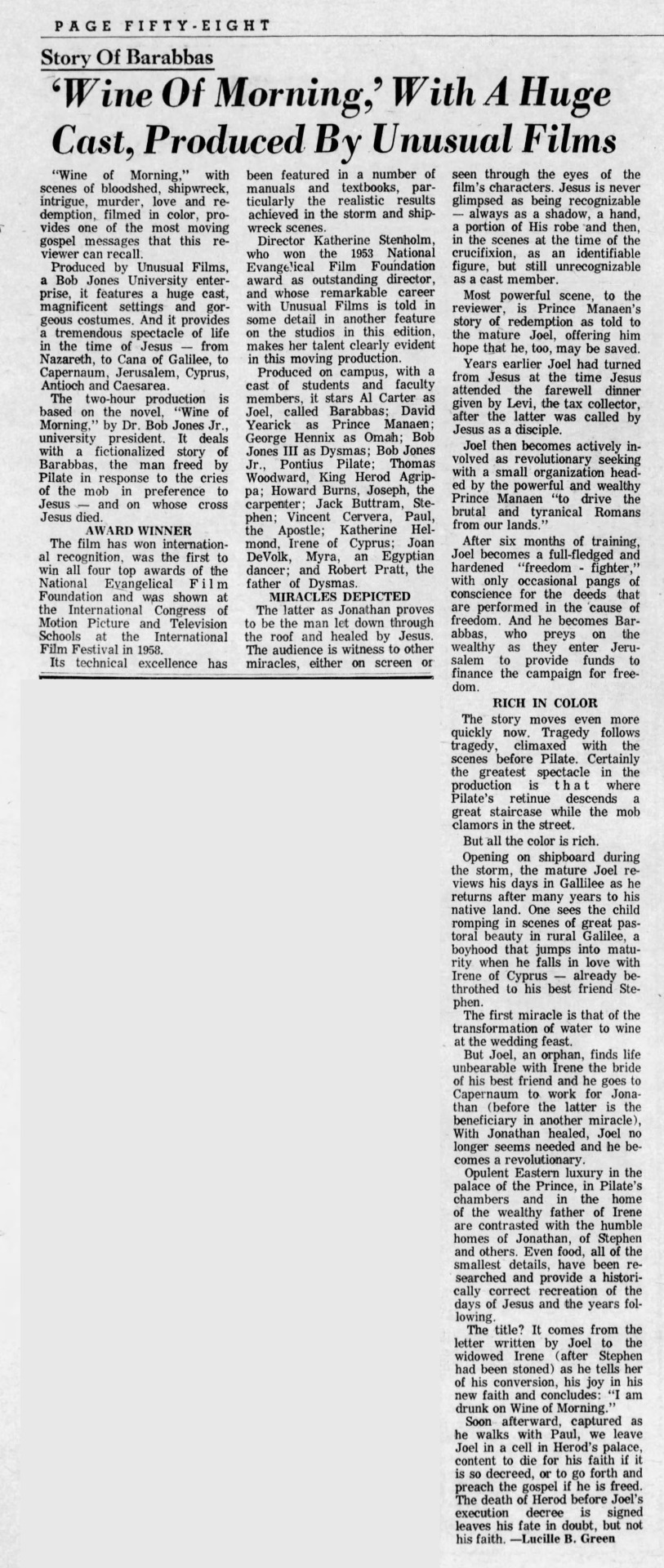
This one has a surprise. Can you see it?
"Wine of Morning," with scenes of bloodshed, shipwreck, intrigue, murder, love and redemption, filmed in color, provides one of the most moving gospel messages that this reviewer can recall.
Produced by Unusual Films, a Bob Jones University enterprise, it features a huge cast, magnificent settings and gorgeous costumes. And it provides a tremendous spectacle of life in the time of Jesus from Nazareth, to Cana of Galilee, to Capernaum, Jerusalem, Cyprus, Antioch and Caesarea.
The two-hour production is based on the novel, "Wine of Morning," by Dr. Bob Jones Jr., university president. It deals with a fictionalized story of Barabbas, the man freed by Pilate in response to the cries of the mob in preference to Jesus - and on whose cross Jesus died.
AWARD WINNER
The film has won international recognition, was the first to win all four top awards of the National Evangelical Film Foundation and was shown at the International Congress of Motion Picture and Television Schools at the International Film Festival in 1958.
Its technical excellence has been featured in a number of manuals and textbooks, particularly the realistic results achieved in the storm and ship wreck scenes.
Director Katherine Stenholm, who won the 1953 National Evangelical Film Foundation award as outstanding director, and whose remarkable career with Unusual Films is told in some detail in another feature on the studios in this edition, makes her talent clearly evident in this moving production.
Produced on campus, with a cast of students and faculty members, it stars Al Carter as Joel, called Barabbas; David Yearick as Prince Manaen; George Hennix as Omah; Bob Jones III as Dysmas; Bob Jones Jr., Pontius Pilate; Thomas Woodward, King Herod Agrippa; Howard Burns, Joseph, the carpenter; Jack Buttram, Stephen; Vincent Cervera, the Paul, Apostle; Katherine Helmond, Irene of Cyprus; Joan DeVolk, Myra, an Egyptian dancer; and Robert Pratt, the father of Dysmas.
Did you see her?

MIRACLES DEPICTED
The latter as Jonathan proves to be the man let down through the roof and healed by Jesus. The audience is witness to other miracles, either on screen or seen through the eyes of the film's characters. Jesus is never glimpsed as being recognizable -- always as a shadow, a hand, a portion of His robe and then, in the scenes at the time of the crucifixion, as an identifiable figure, but still unrecognizable as a cast member.
Most powerful scene, to the reviewer, is Prince Manaen's story of redemption as told to the mature Joel, offering him hope that he, too, may be saved.
Years earlier Joel had turned from Jesus at the time Jesus attended the farewell dinner given by Levi, the tax collector, after the latter was called by Jesus as a disciple.
Joel then becomes actively involved as revolutionary seeking with a small organization headed by the powerful and wealthy Prince Manaen "to drive the brutal and tyrannical Romans from our lands."
After six months of training, Joel becomes a full-fledged and hardened "freedom-fighter," with only occasional pangs of conscience for the deeds that are performed in the cause of freedom. And he becomes Barabbas, who preys on the wealthy as they enter Jerusalem to provide funds to finance the campaign for freedom.
RICH IN COLOR
The story moves even more quickly now. Tragedy follows tragedy, climaxed with the scenes before Pilate. Certainly the greatest spectacle in the production is that where Pilate's retinue descends a great staircase while the mob clamors in the street.
But all the color is rich.
Opening on shipboard during the storm, the mature Joel re views his days in Galilee as he returns after many years to his native land. One sees the child romping in scenes of great pastoral beauty in rural Galilee, a boyhood that jumps into maturity when he falls in love with Irene of Cyprus -- already bethrothed to his best friend Stephen.
The first miracle is that of the transformation of water to wine at the wedding feast.
But Joel, an orphan, finds life unbearable with Irene the bride of his best friend and he goes to Capernaum to work for Jonathan (before the latter is the beneficiary in another miracle), With Jonathan healed, Joel no longer seems needed and he becomes a revolutionary.
Opulent Eastern luxury in the palace of the Prince, in Pilate's chambers and in the home of the wealthy father of Irene are contrasted with the humble homes of Jonathan, of Stephen and others. Even food, all of the smallest details, have been researched and provide a historically correct recreation of the days of Jesus and the years following.
The title? It comes from the letter written by Joel to the widowed Irene (after Stephen had been stoned) as he tells her of his conversion, his joy in his new faith and concludes: "I am drunk on Wine of Morning." Soon afterward, captured as he walks with Paul, we leave Joel in a cell in Herod's palace, content to die for his faith if it is so decreed, or to go forth and preach the gospel if he is freed.
The death of Herod before Joel's execution decree is signed leaves his fate in doubt, but not his faith.
#Bob Jones University#1967#Greenville News#YeahTHATGreenville#Advertisement#Anniversary#Unusual Films#Wine of Morning#Katherine Helmond
0 notes
Text
Through the Bible with Les Feldick LESSON 2 * PART 4 * BOOK 74 CONNECTING THE DOTS OF SCRIPTURE – PART 8 Genesis through Revelation Okay, for those of you joining us on television, just in case you’re catching us for the first time, we’re just an informal Bible study. I always make the point. I’m not trying to attack anyone. And hopefully we can just get people to see what the Book says! I don’t want anyone to go into a Sunday school class and say, “This is what Les Feldick says.” That doesn’t amount to anything. Be able to say, hey, this is what the Book says. Hopefully we’re making some headway. All right, we’re going to keep right on with our subject of the physical attributes and the qualities of this Earthly Kingdom that’s coming. And now we’re going to move on up to the next of the Major Prophets, Ezekiel. So, those of you in the studio can be turning with me to Ezekiel chapter 47. We’re going to start reading at verse 1. And again, I’m going to do like I’ve been doing all afternoon. We’re going to do more reading than usual, but hopefully the Scripture can speak for itself if you understand what we’re trying to show: that these are all promises given to the Nation of Israel that’s in their future. It hasn’t happened yet, but it’s going to happen! All right, verse 1. Ezekiel 47:1-2 “Afterward he brought me again unto the door of the house; and, behold, waters issued out from under the threshold of the house eastward: for the forefront of the house stood toward the east, (He’s speaking of this millennial building in Jerusalem.) and the waters came down from under the right side of the house, at the south side of the altar. 2. Then he brought me out of the way of the gate northward, and led me about the way without unto the utter gate by the way that looketh eastward; and, behold, there ran out waters on the right side.” All right, now we looked at these before. But here is this river of water that’s going to come out from underneath the throne room there in Jerusalem during the millennium. The river will run out east to the Dead Sea, and it will totally cure the Dead Sea and make it fresh water. Everything that’s associated with the water that flows to the Dead Sea will cause life to come. That’s opposite of what the Dead Sea is now. Then the other half of the river will flow west to the Mediterranean. This is all during this 1,000 year reign of Christ. All right, let’s move on a few verses, and then we’re going to go on into the Book of Daniel. All right, verse 7. Ezekiel 47:7-8a “Now when I had returned, behold, at the bank of the river were very many trees on the one side and on the other. 8. Then he said unto me, (Now this, I think, is an angel speaking to Ezekiel.) These waters issue out toward the east country, and down into desert, and go into the sea:” Now if you know Jerusalem, we can stand on the Mount of Olives and on a nice clear day you can almost see the Dead Sea. That’s east about 18 or 20 miles, if I remember right, from Mount of Olives in Jerusalem. All right, so this is what he’s talking about. From under the sanctuary this water or this river will flow east to the desert and into the Dead Sea. Ezekiel 47:8b-9a “…which being brought forth into the sea, the waters shall be healed. (That is into the Dead Sea. These waters are going to be so pure that they will purify the salty, mineralized waters of the Dead Sea.) 9. And it shall come to pass, that every thing that liveth, which moveth, whithersoever the rivers shall come, shall live: (In other words, it’s going to be a water of life, or it’ll be life-giving water.) which moveth, whithersoever the rivers shall come, shall live: and there shall be a very great multitude of fish, because these waters shall come thither: for they shall be healed;…” If you’ve been to the Dead Sea, and many of you have, I’m sure. Absolutely nothing lives in the Dead Sea. Nothing, because it is so saturated with salt and minerals. That’s why you can’t sink in it.
You float. I’ll never forget the time my dear little wife over here tried to swim in the Dead Sea, and it just flipped her upside down. She wasn’t quite ready for it. But, that’s what it is. This water from the mountain in Jerusalem is going to totally change the Dead Sea to a fresh water sea. Ezekiel 47:10a “And it shall come to pass, (See, it has never happened yet, but it’s going to.) that the fishers (fishermen) shall stand upon it from En-gedi even unto En-egliam; there shall be a place to spread forth nets;…” Now, someone just asked me at break time: are we going to eat meat in the millennium? That is, if we’re there. I’m still not sure whether Church Age people are going to be in the millennium or not. Because after all, they’re so separated from Israel in so many ways; I’m not putting us automatically in the millennium. But anyhow, are the citizens of the millennium, the humans, the people who have come in at the front end (Israel as well as Gentiles), are they going to eat beef? I don’t think so. Because there’ll be no death, and you’d have to kill them to eat them. Here’s what made me think of it. What was my answer? We’ll probably eat fish. It’ll probably be the main diet, because the fishermen are going to stand on the shores of the Dead Sea, now made fresh. So we know they’re going to eat fish. They’re not going to catch them just for nothing. Ezekiel 47:10b “…to spread forth nets; their fish shall be according to their kinds, as the fish of the great sea, exceeding many.” The Mediterranean. In other words, every species of fish that is now in the Mediterranean will also be in the Dead Sea. Now that seems unbelievable, but the Scripture promises it. All right, then verse 11. Ezekiel 47:11-12 “But the miry places thereof and the marshes thereof shall not be healed; they shall be given to salt. 12. And by the river upon the bank thereof, on this side and on that side, shall grow all trees for (What?) food, whose leaf shall not fade, neither shall the fruit thereof be consumed: it shall bring forth new fruit according to his months, because their waters they issued out of the sanctuary: and the fruit thereof shall be for food, and the leaf thereof for medicine.” Now that doesn’t mean to cure disease, but it’s therapeutic to maintain good health. Well, those are all statements concerning this glorious Earthly Kingdom. Now, let’s skip over to Daniel chapter 2. This is the fourth Major Prophet that also speaks of this glorious Earthly Kingdom. And remember, in Daniel’s previous verses he has seen the image of Nebuchadnezzar’s dream, which was prophetic of all the Gentile empires that would be coming up through history from 600 B.C. as we had it on the board. Again remember, that Daniel writes from this exile to Babylon in 600 B.C. All right, so from Daniel’s time on, all these Gentile Empires will be holding forth and will be occupying and controlling the city of Jerusalem—first the Babylonians, then the Medes and Persians, and then the Greeks, and then the Romans. All right, so that takes us on up past the time of Christ until the Roman Empire disappears. Now again, just for a quick review, remember that this is the only timeline that the Old Testament and the Four Gospels, the first eight chapters of Acts, and then the little epistles at the end of our Bible including Revelation, this is the only timeline they understand. Because Paul doesn’t appear until Stephen is martyred. We’ll see that in our next taping. When Stephen is martyred, as I just talked to somebody at break time, who are we introduced to? Saul of Tarsus. And what does that mean? A whole change of modus operandi. Instead of Christ and the Twelve holding forth, all based on these prophecies that we’ve been looking at all afternoon, all of a sudden all this is put on hold. We go into something totally different that no other portion of Scripture has any knowledge of. And that’s why it’s referred to over and over as a secret held in the mind of God until He revealed it to the Apostle Paul.
And that’s why I’ve become more Pauline with every day that I get older. Because if Paul doesn’t teach it; then you have to careful, because he alone is the Apostle of the Gentiles (Romans 11:13). And that turns people off. Tough luck. I mean, you’d better accept it, because that’s the way it is. And if Old Testament promises agree with some of the things that Paul gives, great. But if they don’t, then they’re not valid. Because he alone is the Apostle of the Gentiles. But here we’re still dealing with the Old Testament, so back to Daniel 2, again, verse 44. Daniel 2:44a “And in the days of these kings (That is, starting with Nebuchadnezzar and those other four great empires leading up to the time of Christ’s earthly ministry.) in the days of these kings shall the God of heaven set up a kingdom, which shall never be destroyed:…” In other words, after all these Gentile empires have come and gone and the Tribulation unfolds. Now remember, there’s nothing in here of the Church Age. Keep that out of your thinking. This is all part of the prophetic scriptures. After all these empires have come and gone and the Tribulation has passed, then “shall the God of Heaven set up a kingdom, which shall never be destroyed.” And I always maintain that the 1,000 year millennium will slip right on into the eternal, somehow or other. I can’t explain it, but evidently it’s going to go into eternity. Daniel 2:44b-45 “…which shall never be destroyed: and the kingdom shall not be left to other people, but it shall break in pieces and consume all these kingdoms, and it shall stand for ever. (Why?) 45. Forasmuch as thou sawest (Now remember, this is God speaking to Daniel, and Daniel is in turn interpreting Nebuchadnezzar’s dream.) that the stone was cut out of the mountain without hands, (So, it’s a reference to Christ’s Second Coming.) and that it broke in pieces the iron, the brass, the clay, the silver, and the gold; the great God (the God of Creation) hath made known to the king what shall come to pass hereafter: and the dream is certain, and the interpretation thereof sure.” Now, what it really amounted to is that these great empires that had come and gone were depicted in this huge image in Nebuchadnezzar’s dream. The stone would strike it on its feet. It would roll it down like a steam roller until there was nothing left but dust and chaff, and it would blow away into the dust bin of eternal history. And Christ’s Kingdom would become a reality. Well, now let’s move on over in the Book of Daniel to chapter 7. Now, instead of interpreting a dream of someone else’s, Daniel has his own. He has his own vision in chapter 7. Let’s jump in at verse 9. He sees the same series of empires, only he sees them as carnivorous beasts of prey. But he still sees the Babylonian, the Medes and the Persians, the Greeks, and the Romans; and how they would occupy Jerusalem over various periods of time. All right, but now you come up to verse 9. In his vision, in his dream-- Daniel 7:9 “I beheld till the thrones (of these Gentile Empires) were cast down, and the Ancient of days did sit, (I feel this is a reference to God the Father who is on the Throne.) whose garment was white as snow, and the hair of his head like the pure wool: his throne was like the fiery flame, and his wheels as burning fire.” Then come all the way over to verse 13. Daniel 7:13 “I saw in the night visions, and, behold, one like the Son of man (That’s Christ again in an Old Testament analogy.) came with the clouds of heaven, and came to the Ancient of days, (That is, to God the Father.) and they brought him near before him.” Now, anytime I teach verse 13, I can’t help it even though we’ve done it not too long ago, come all the way with me up to Revelation chapter 5, because it’s a perfect parallel. Just see how beautifully this corresponds. Daniel sees the Son of Man coming before God the Father. John the Revelator sees almost the same thing. Revelation 5:1 “And I saw in the
right hand of him who sat on the throne (in the hand of God the Father) a book written within and on the backside, sealed with seven seals.” Now for sake of time, I’m going to take verse 3. Revelation 5:3-4 “And no man in heaven, nor in earth, neither under the earth, was able to open the book, neither to look thereupon. 4. And I wept much, because no man was found worthy to open and to read the book, neither to look thereon.” Now you remember when I taught this, this was a mortgage, in type. Satan is holding the mortgage on planet earth and only one can pay it off. And that is Christ the Son of God. All right, verse 5. Revelation 5:5 “And one of the elders saith unto me, Weep not: behold, the Lion of the tribe of Judah, (which is Jesus the Christ) the Root of David, hath prevailed to open the book, and to loose the seven seals thereof.” Revelation 5:6a “And I beheld, and, lo, in the midst of the throne and of the four creatures, in the midst of the elders, stood a Lamb as it had been slain, having seven horns and seven eyes, which are the seven Spirits of God…” Which is another description of God the Son—who has now finished the work of the Cross. He’s ascended back to Glory. And now it’s time to fulfill prophecy. Verse 7. Revelation 5:7 “And he came and took the book out of the right hand of him who sat upon the throne.” Now verse 9. Revelation 5:9-10 “And they sang a new song, saying, Thou art worthy to take the book, (or this mortgage) and to open the seals thereof: (And to be able to start paying it off, which of course Christ will do with the seven years of Tribulation. And this is why He can do what He’s doing.) for thou wast slain, and hast redeemed us to God by thy blood out of every kindred, and tongue, and people, and nation; 10. And hast made us unto our God kings and priests: and we shall reign on the earth.” All right, now come back to Daniel chapter 7 and we’ll start at verse 14. Remember, these are all the promises given to the Nation of Israel. So, after God the Son comes before the Ancient of Days, put in what He did in the Book of Revelation where He took the mortgage, and He paid it off, and Satan is totally defeated. Paid off, and he’s imprisoned in the abyss and in comes the Kingdom. Verse 14. Daniel 7:14 “And there was given him (God the Son) dominion, and glory, and a kingdom, (and in this kingdom) that all people, nations, and languages, should serve him: his dominion is an everlasting dominion,(Here, again, it makes it sound like this Kingdom is going to go beyond the 1,000 years.) which shall not pass away, and his kingdom that which shall not be destroyed.” And it’s a visible, earthly, political monarchy, benevolent kingdom, animal kingdom with humans: children, babies, and adults. No death. No suffering. No sickness. It’s going to be Heaven on earth. Why is that so hard to comprehend? Well, let’s look some more. Hosea, I want to go to chapter 4. I might as well start at verse 1. Oh goodness, time’s just about gone again. Hosea chapter 4 verse 1. Hosea 4:1-4 “Hear the word of the LORD, ye children of Israel: (Now, is there any doubt who this is written to? This has nothing to do with us Gentiles. This is God dealing with Israel.) for the LORD hath a controversy with the inhabitants of the land, because there is no truth, nor mercy, nor knowledge of God in the land. 2. By swearing, and lying, and killing, and stealing, and committing adultery, they break out, and blood toucheth blood. 3. Therefore shall the land mourn, and every one that dwelleth therein shall languish, with the beasts of the field, and with the fowls of the heaven; yea, the fishes of the sea also shall be taken away. 4. Yet let no man strive, nor reprove another: for thy people are as they that strive with priest.” Hosea 4:5-6 “Therefore shalt thou fall in the day, and the prophet also shall fall with thee in the night. and I will destroy thy mother. 6. My people are destroyed for lack of knowledge; because
thou hast rejected knowledge, I will also reject thee, that thou shalt be no more priest to me: seeing thou has forgotten the law of thy God, I will also forget thy children.” All right, now we come all the way down, and I want to bring you over to the chapter where—I was thinking chapter 10. Come all the way over to Hosea chapter 10. Now again, we’ve backed up a little bit into Israel’s time of chastisement and wrath, but here comes their final blessing. Hosea 10:12-13 “Sow to yourselves in righteousness, reap in mercy; break up your fallow ground: (In other words, it’s been out of production.) for it is time to seek the LORD, till he come and rain righteousness upon you. 13. Ye have plowed wickedness, ye have reaped iniquity: ye have eaten the fruit of lies: because thou didst trust in thy way, (in other words, their human understanding) in the multitude of thy mighty men.” Hosea 10:14-15 “Therefore shall a tumult arise among thy people, and all they fortresses shall be spoiled, as Shalman spoiled Beth-arbel in the day of battle: the mother was dashed in pieces upon her children. 15. So shall Beth-el do unto you because of your great wickedness: in a morning shall the king of Israel utterly be cut off.” But now we come all the way down to the ultimate blessing in chapter 13 verse 9. Remember, all the way through the prophets it was chastisement and blessing. Chastisement followed with blessing. And here comes the final, the setting up of this glorious Kingdom in verse 9 chapter 13. Hosea 13:9-10a “O Israel, thou hast destroyed thyself; (in other words, because of their unbelief) but in me (The Lord is speaking.) is thine help. 10. I will be thy (What?) king:…” All the way through Scripture we’ve got this coming King ruling over this glorious Earthly Kingdom. Hosea 13:10-11 “I will be thy king: where is any other that may save thee in all thy cities? And thy judges of whom thou saidst, Give me a king and princes. 11. I gave thee a king in mine anger, and took him away in my wrath.” Then come down to verse 14. Hosea 13:14-15a “I will ransom them from the power of the grave; I will redeem them from death: O death, I will be thy plagues; O grave, I will be thy destruction: repentance shall be hid from mine eyes. 15. Though he be fruitful among his brethren, an east wind shall come, the wind of the LORD shall come up from the wilderness, and his spring shall become dry, and his fountain shall be dried up:…” Hosea 13:16a “Samaria shall become desolate; for she hath rebelled against her God:…” Hosea 14:1 “O Israel, return unto the LORD thy God; for thou hast fallen by thine iniquity.” Let’s move on to Zephaniah, if I can find it, chapter 3 verse 14. And this will take us, I imagine, to the end of the half-hour. Zephaniah chapter 3 verse 14, what’s the first word? “Sing.” That’s the opposite of oppression and wrath. Zephaniah 3:14-15 “Sing, O daughter of Zion; shout, O Israel; be glad and rejoice with all the heart, O daughter of Jerusalem. 15. The LORD hath taken away thy judgments, he hath cast out thine enemy; the king of Israel, even the LORD (See that? That’s Jesus of Nazareth. The God of Glory.) is in the midst of thee: thou shalt not see evil any more.” Zephaniah 3:16-17 “In that day it shall be said to Jerusalem, Fear thou not: and to Zion, Let not thine hands be slack. 17. The LORD thy God in the midst of thee is mighty; he will save, he will rejoice over thee with joy; he will rest in his love, he will joy over thee with singing.” All right, now I think for sake of time I almost have to skip a verse or two here. Come down to verse 19. Zephaniah 3:19-20 “Behold, at that time I will undo all that afflict thee: and I will save her that halteth, (or the lame) and gather her that was driven out; and I will get them praise and fame in every land where they have been put to shame. 20. At that time I will bring you again, even in the time that I gather you: for I will make you a name and a praise among all people of the earth, when I turn back your captivity before your eyes, saith the LORD.”
Okay, now if you can turn real quickly to Zechariah chapter 14. This is a verse that we’ve used over and over through the years where it makes it as plain as language can make it. If I had time, I’d like to start at verse 1, but we can’t do it. We’ve got 30 seconds left. Zechariah 14:9 “And the LORD (That’s God the Son, that’s Jesus of Nazareth, that’s Jesus the Christ.) shall be (at some future time) king over all the earth: in that day there shall be one LORD, and his name one.”
0 notes
Text
GVL / Holding Pattern

Holding Pattern Tiger Strikes Asteroid Greenville, Greenville, SC + KMAC Museum, Louisville, KY
Exhibition Dates
KMAC: March 3 - April 9 Reception: March 3 Artist talk: April Dauscha March 18 Artist talk: Nneka Kai March 30
TSA GVL: April 21 - May 20 Reception: May 5
Tiger Strikes Asteroid Greenville (TSA GVL) artist collective and KMAC Museum are excited to present Holding Pattern, a 6-artist exhibition that investigates fiber arts as a form of modern technology in Louisville, KY and Greenville, SC.
Over the past decade, the value of what we call “technology" became largely correlated with its ability to gather and hold information — data. Today — in algorithms and AI, science and social media — the highest value is assigned to technologies that hold data and the stories that can be derived from it to give it meaning.
But is this really new? Holding Pattern examines how fiber arts helped create the template for our current understanding of what makes a technology valuable, and how contemporary works deserve consideration as technologies that hold both data and story. And, while fiber artwork that employs contemporary digital is usually framed as doing something “new,” it actually reveals a relationship that already existed.
Artists Danielle Burke, April Dauscha, Nneka Kai, Elysia Mann, Keysha Rivera, Skye Tafoya
Co-curated by Tiffany Calvert, Jennifer Oladipo & Kelsey Shaeffer, members of Tiger Strikes Asteroid Greenville
Artist Bios
Danielle Burke Danielle (Dani) Burke is an artist and folklorist. She studies textiles, craft pedagogy, and artist communities; her studio practice focuses primarily on the structure and storytelling potential of woven cloth. She is currently a PhD student in Design Studies (history) within the School of Human Ecology at the University of Wisconsin-Madison.
April Dauscha Born and raised in Louisville, Kentucky, April Dauscha received her BFA in fashion design at the International Academy of Design and Technology and her MFA in fiber from Virginia Commonwealth University. April has served on the board of directors for the Surface Design Association (SDA) and is one of the founding members of Tiger Strikes Asteroid Greenville (TSA GVL). She has been represented by Page Bond Gallery in Richmond, Virginia and her work has been featured in Vogue Portugal. She has exhibited her work nationally, at the Fuller Craft Museum, MANA Contemporary, and Tracey Morgan Gallery, and internationally in Berlin, Cape Town, Jerusalem, and Belgrade. She is currently heading the fiber arts program at the Fine Arts Center, a performing and visual arts high school, in Greenville, South Carolina. Her work can be seen here at www.aprildauscha.com .
Nneka Kai Nneka Kai is an interdisciplinary artist from Atlanta, GA, whose practice is rooted in the exploration of personal and archival narratives through the material of hair. She received her MFA from the Art Institute of Chicago, where she was a research assistant at the Textile Resource Center. There she explored the history and conservation aspects of textiles within the Fiber & Material Studies collection. Not seeing herself represented in the objects, she decided to research the peripherals of textiles, in hopes of uncovering Black women’s material sensibilities throughout the diaspora. She also received her BFA from Georgia State University, where her material studies sparked her curiosity for hair. Currently, Nneka’s studio practice explores these findings through fiber, sculpture, and performance works, emphasizing methods of abstraction and opacity. She has performed her works in Chicago, Atlanta, and North Carolina. In 2021, Nneka exhibited in the Hair Stories Exhibition at The Newport Art Museum in Rhode Island. She is currently working as an art teacher while exploring her home in Atlanta, Georgia as a site of Black presence and preservation.
Elysia Mann Elysia Mann is a studio technician at the University of Tennessee and is a member of Knoxville’s Relay Ridge community studios and printshop. She was the co-founder of a collaborative print shop in St. Louis called All Along Press where she published fine art prints and letterpress editions. She holds a BFA in Printmaking from Washington University in St. Louis and an MFA in Studio Art from the University of Tennessee. Her work combines print, textile, and poetry and has been shown nationally including upcoming exhibitions at the KMAC Museum in Louisville and Tiger Strikes Asteroid in Greenville. Website: elysiaaileenmann.com.
Keysha Rivera Keysha Rivera is a textile and media artist of Afro-Indigenous ancestry. Rivera combines traditional craft and contemporary digital technologies. Her work revolves around cultural preservation and the configuration of displaced histories.
Her work being rooted in the connection of material and process, she creates soft sculptures, paintings, and installations that point to the conversation around the vulnerability of home, Caribbean identity and the tenderness of memory and remembrance.
Her familial research acts as a guide for the creation of works. By centering Puerto Rican liberation, her art functions as a contemporary form of resistance to the present-day realities.
Skye Tafoya skye tafoya is an indigenous artist from the eastern band cherokee and santa clara pueblo tribes. her tribal heritage and lineage are significant components continuously present within her artwork. skye comes from a lineage of basket-weavers, both paternal and maternal, and also used to make red willow baskets with her dad. skye continues to use paper-weaving processes to honor her loved ones and ancestors. her meticulously crafted designs, patterns, prints, and weavings are influenced by basketry and contains themes of cultural teachings, cherokee language preservation, motherhood and personal & family narratives. skye creates with the intention of archiving, preserving and sharing stories, language, culture, and experiences.
skye has worked in both two-dimensional and three-dimensional forms ranging in sizes from hand-held to life-size. the methods of her art practice include serigraph (screen-printing), relief and letterpress printmaking, digital design, paper-weaving, and book-making.
skye published her first artist book, ul’nigid’, in the spring of 2020 and has exhibited work nationally and internationally in russia. her work is also housed in many special collections including the u.s. library of congress, kohler art library, and the bainbridge museum of art. she received her b.f.a. from the institute of american indian arts in santa fe, nm and her m.f.a. from the pacific northwest college of art in portland, or.
0 notes
Text
Financial Planning & Investment Management
My research involved conversations with teachers, residents and expatriate immigrants alike; I also collected souvenirs and wrote postcards residence, and visited sites within the city centre and in the peripheral suburbs. The act of journeying has long been an inherent a half of inspiring and constructing aladdin tent rentals architecture, and on this spirit I will reflect upon my own expertise and Wright’s recollections. My observations can only be preliminary and speculative, but they shed a different view to the contemporary bombastic structure in so many cities on the western coastline of the Persian Gulf.
See the Garden of Gethsemane, stop for pictures at the Mount of Scopus, and then drive to Bethlehem to discover Manger Square, together with the Church of the Nativity, as your information shares the secrets and tales behind each landmark. Lace up your skates for two very totally different and equally magical experiences on ice. A notable camp runway moment aladdin tents came again in February 2018, when Gucci despatched fashions strutting down the catwalk holding their very own severed heads. Fittingly sufficient, Met Gala co-chairs Styles and Michele just lately collaborated on a campy campaign that featured literal chickens for a menswear assortment.
From Manger Square to the Church of the Nativity, Milk Grotto, and the Shepherds’ Field, you’ll cowl essential Biblical websites with a information who can help unlock the historical past behind every destination; pickup at a central location in Jerusalem or Tel Aviv will get you on the highway with no fuss. Selecting a area aladdin tent might change the language and promotional content material you see on the Adobe Stock website online. That conflicting mix of attraction and displeasure is what makes camp style such a paradox. It can simultaneously be stunning and overwhelmingly cheesy.
Not solely that, but the determination to apparently have the character lean in to regressive stereotypes about gay men, if The Sun's report is to be believed, additional angered folks on social media. With the studio and Whitehall staying silent about the report, we'll have to wait until July 24, 2020, when Jungle Book hits theaters, to see simply how this all shakes out. When it was introduced that Naomi Scott could be bringing Princess Jasmine to life in the just lately released live-action adaptation of Aladdin, directed by Guy Ritchie, it came on the heels of reviews that the studio was allegedly having bother discovering Arab and Asian actors who could sing.
Plants required for school yard greening plan are very expensive. Kelly has an account that saves her 20 p.c at Meadow Acres nursery. If you're seeking to end your weekend with a Halloween celebration, I have the perfect resolution for you. October 31 will be Fanshawe's Halloween pub in Forwell Hall. At Fanshawe, we know how to have fun great events, so come verify this one out.
Virgil Abloh for Off-White is one more designer who unapologetically employs camp influences in his designs. His signature use of citation marks, for instance, provides an ironic twist to what would in any other case be a standard sweatshirt or a pair of sneakers. All-fiberglass, ultralight Topo-2 off-road travel aladdin tents durban trailer proves that consolation and stylishness can associate with sturdiness even on unbeaten paths. In 1966 Aladdin came out with a small canned-ham model often recognized as Hideaway with a length of 13 ft 7 inches.
The area’s best-known mansion is Hycroft, a private membership whose year-round public occasions invite friends to correctly discover the totally restored Edwardian building and grounds. Residents of Shaughnessy shopped along South Granville, which quickly became a hub for high-end boutiques, galleries and sweetness providers. The Stanley Industrial Alliance Theatre debuted in 1931, charging admission charges not more than forty cents with reveals comprising a feature production, comedy and newsreel. The landmark theatre was designed with neoclassical inside and artwork deco exterior, and finished with beautiful tiles, chandeliers and carpeting. This summer there could be lots going on on the Canadian Canoe Museum, each on- and offsite. The Voyageur Canoe Tour experience on the Peterborough Lift Lock provides scheduled rides, together with personalized excursions, for groups.
Investors should communicate to their tax skilled for specific data relating to their tax scenario. Investment involves danger together with possible loss of principal. International investing entails dangers, including risks related to international forex, restricted liquidity, less authorities regulation, and the potential for substantial volatility as a end result of adverse political, economic or different developments. These risks are sometimes heightened for investments in emerging/developing markets or smaller capital markets. In Canada,this material is meant for permitted purchasers solely, is for instructional purposes only, does not constitute funding advice and shouldn't be construed as a solicitation or offering of units of any fund or different safety in any jurisdiction. This materials might comprise “forward-looking” info that's not purely historical in nature.
It was named after CPR president Sir Thomas Shaughnessy, and envisioned because the “Nob Hill of Vancouver”, impressed by San Francisco’s poshest district. This is considered the official birthdate of South Granville. Their work is out there on the market in the gallery at Kawartha Potters Guild where they participate within the two annual Christmas and spring reveals.
0 notes
Text
Man Victor




#m#1974#rumanía#academia de artes plásticas Cluj#Jerusalem studio school#premio artista del año deustche bank#bienal de venecia
0 notes
Note
Michael Holbrook Penniman Jr.[6][7][8] (born 18 August 1983), known by his stage name Mika (/ˈmiːkə/ MEE-kə, stylised as MIKA), is a Lebanese-born British singer-songwriter.
After recording his first extended play, Dodgy Holiday, Mika was named the number-one predicted breakthrough act of 2007 in an annual BBC poll of music critics, Sound of 2007.[9] Mika released his first full-length studio album, Life in Cartoon Motion, on Island Records in 2007, which sold more than 5.6 million copies worldwide and helped Mika win a Brit Award—winning Best British Breakthrough act—and receive a Grammy Award nomination.[10] He topped the UK Singles Chart in January 2007 with "Grace Kelly". He has since gone on to record four more studio albums (most recently My Name is Michael Holbrook released in October 2019), as well as serve as judge/mentor on both the French version of The Voice and the Italian version of X Factor. Mika has also starred in his own television variety show in Italy, Stasera Casa Mika [it], which won the 2017 Rose d'Or Award for Entertainment, and co-hosted the Eurovision Song Contest 2022.
Contents
1Life and career
1.11983–2006: Childhood and early career
1.22007–2008: Life in Cartoon Motion
1.32009–2010: The Boy Who Knew Too Much
1.42010–2014: The Origin of Love, X Factor Italy and Songbook Vol.1
1.52015–2018: No Place in Heaven
1.62019–2020: My Name Is Michael Holbrook
1.72021–present
2Personal life
3Discography
4Filmography
5Tours
6Awards and nominations
7References
8External links
Life and career
1983–2006: Childhood and early career
Mika was born in Beirut, the third of five children (three sisters Yasmine, Paloma and Zuleika and one brother Fortuné), to an American-born Lebanese mother and an Israeli-born American father, Mary Joan "Joannie" (née Mouakad, daughter of John Mouakad and Odette Farah) and Michael Holbrook Penniman (son of William Frederick Penniman III and Dorothy Dyar). His father was a banker[7][11] and was born in Jerusalem, where his own father – Mika's paternal grandfather William Frederick Penniman III – was a diplomat.[11][12] Mika's maternal grandfather John Mouakad was Syrian (from Damascus).[13][14]
When Mika was a year old, his family was forced to leave war-torn Lebanon and moved to Paris, France.[12][15] The first piano piece he learned to play was "Les Champs-Élysées", by Joe Dassin.[12] At the age of 7, he wrote his first song, a piano instrumental called "Angry", which he describes as "awful".[7] The family moved to London when he was 9 years old. There, he attended the Lycée Français Charles de Gaulle, where he experienced severe bullying. He also had problems with dyslexia. In response to these experiences Mika was home-schooled by his mother at the age of 12, for six to eight months.[7] He then attended St Philip's School in Kensington, where he was the head of the Schola Cantorum (the St. Philip's Choir). Later he attended Westminster School and the Royal College of Music, which he left to record his first album at Casablanca Records.[16] As a child Mika was trained by Alla Ardakov (Ablaberdyeva), a Russian opera professional.
Mika's first single was a limited 7"/download release called "Relax, Take It Easy" (2006). It was play-listed by UK's BBC Radio 1 and was made Record of the Week by DJ Scott Mills. The Dodgy Holiday EP also became available for download. The song "Billy Brown" was available for free download for a week from the iTunes Store. A song titled 'Over-rated', which was recorded in 2004, was "unofficially" released online. His debut radio appearance was on Dermot O'Leary's BBC Radio 2 show in September 2006.
2007–2008: Life in Cartoon Motion
WHO
7 notes
·
View notes
Video
youtube
Happy Birthday Ian Anderson, born 10 August 1947 in Dunfermline.
After attending primary school in Edinburgh, his family relocated to Blackpool in 1959. Following a traditional Grammar school education, he moved on to Art college to study fine art before deciding on an attempt at a musical career. He was influenced by his father’s big band and jazz records and the emergence of rock music, but was disenchanted with the “show biz” style of early American rock and roll stars like Elvis Presley.
In 1963 with some school friends he formed his first band The Blades, a soul and blues outfit. In 1965 they regrouped into The John Evan Band with major lineup changes. They disband two years later when Anderson moved to Luton. In his new surroundings, Ian meets the drummer Clive Bunker and the guitarist Mick Abrahams and with Glenn Cornick, a bassist - of The John Evan Band-, Anderson creates the seed of the group that would become the legendary Jethro Tull.
Still enjoying a lengthy if intermittent ongoing career, Jethro Tull has released 30 studio and live albums, selling more than 60 million copies since the band first performed at London’s famous Marquee club.
After undertaking more than 3000 concerts in forty-something countries throughout four decades, Tull has played typically 100 concerts each year to longstanding, as well as new fans worldwide.
Widely recognized as the man who introduced the flute to rock music, Ian Anderson remains the crowned exponent of the popular and rock genres of flute playing. So far, no pretender to the throne has stepped forward. Ian also plays ethnic flutes and whistles together with acoustic guitar and the mandolin bouzouki, balalaika, saxophone, harmonica, and a variety of whistles.
I briefly met Ian on Skye in 1987 on my way back from Benbecula where he had an estate and ran a Fish farm, well 11 fish farms as my research has unearthed, he also employed over 400 people before selling it in the 90’s.
Anderson recalled in an interview how he started as a flautist…
“ once owned a 1960s Fender Stratocaster, which had previously belonged to Lemmy Kilminster before he found fame with Motorhead. But when it dawned on me I was never going to catch up with the growing band of hotshot British guitarists at that time – Jimmy Page, Jeff Beck and Eric Clapton – I traded it in for a Selma Goldfield student flute worth £30.
I knew Jimmy Page and Eric Clapton didn’t play the flute, so I thought I would be in with a chance. A lot of people told me it was a ridiculous trade because the Strat was worth at least £150. But in fact it was a great buy because learning to play it was the start of Jethro Tull.”
Anderson lives on a farm in the southwest of England where he has a recording studio and office. He has been married for 37 years to Shona who is also an active director of their music and other companies. They have two children.
In 2006 and 2010, he was awarded Doctorates in Literature from Heriot Watt University in Edinburgh and the Abertay University of Dundee. He received the Ivor Award for International Achievement in Music.
Ian admits he owns no fast car, never yet having taken a driving test, and has a wardrobe of singularly uninspiring and drab leisurewear varying from light grey to black in colour. He still keeps a couple of off-road competition motorcycles, and a saxophone which he promises never to play again.
I have a lot of respect for Ian Anderson, he seems a down to earth guy, in an interview he was askedwho he banked with and replied he used to be with the Bank of Scotland and RBS, or just ‘The Bank’ and 'The Royal’ as I think we all call them here in Scotland.
The band are embarking on a European tour soon, including dates in Perth and Glasgow
I’ve chosen a beautiful song called Coronach by Jethro Tull, the Youtube video along with it has some great footage of Skye, Sutherland, the Highlands and Eilean Donan Castle.
Coronach
Grey the mist — cold the dawn; Cruel the sea and stern the shore Brave the man who sets his course for Albion
Sweet the rose — sharp the thorn; Meek the soil and proud the corn Blessed the lamb that would be born Within this green and pleasant land Hi-O-Ran-I-O Hi-O-Ran-I-O
Brown furrow shine Beneath the rain washed blue Bright crystal streams From eagle mountains born Fortune has smiled on those who wake anew Within this fortress nature built To stay the hand of war
With the wind from the east Came the first of those who tread Upon this stone, this stone of kings; This realm, this new Jerusalem Hi-O-Ran-I-O Hi-O-Ran-I-O
41 notes
·
View notes
Link
I’m not a broadcaster, not a journalist, not a policy-shaping official. But I have things I feel ought to be heard and known about one of the world's most important media platforms, the BBC.
I am writing now because there is an important, sober and factual expose of the problems there in today's edition of a British weekly ["Shame of BBC Arabic as systematic bias revealed | A JC investigation shows a pattern of anti-Israel bias and inaccuracies", Jewish Chronicle, February 3, 2021].
I am quoted briefly there but want to raise some larger aspects of the deeply disturbing affair.
On November 9, 2020 I took part in an intense meeting with senior executives at the BBC. The subject was a complaint I had published some weeks earlier [see “Why does BBC promote my daughter’s murderer?” Arnold Roth/Palestinian Media Watch, October 13, 2020] about a Jordanian woman, a fugitive from US justice, being given the celebrity treatment before a global audience tuned in to a BBC show that has a huge following among Arabic speakers.
The meeting, by video conference, was at my request.
I was and continue to be impressed that the senior executive at BBC World Service responded positively to me and without hesitation. He could easily have ignored or deflected what was clearly an uncomfortable proposal. That’s pretty much what the vast majority of media organizations and their editors and management with whom I have tried to engage have done during the past four years.
Is this because I am rude? Nasty? Perhaps, but I believe it has more to do with how I bring disturbing messages with me.
But first some needed background.
My daughter, Malka Chana Roth, a beautiful high school student with a sunny disposition, was one of 15 innocent people murdered in a pizzeria attack carried out by Islamist terrorists in the center of the city where we live, Jerusalem, on August 9, 2001. A sixteenth victim remains in a coma all these years later.
That Islamist terrorist, who was 21 years old at the time and responsible for selecting the target and planting the bomb, was a part-time news-reader at a Palestinian Arab TV station and personally reported the news on camera some hours after engineering the massacre. She went on to publicly call the savagery “my operation”. She has been explicit about how she wanted her victims to be children and took pains to ensure that is what happened. In this she succeeded on a monstrous scale.
My wife and I are battling to see the woman whom the BBC so generously profiled in its October 2020 broadcast, Ahlam Tamimi, locked up for life in a maximum-security prison. Dedicated investigators, prosecutors and agents in the US Department of Justice are too.
This is a battle we have waged – in the literal sense, a fight for justice – since February 2012. There have been meaningful achievements along the way, most notably the unveiling of terror charges against Tamimi on March 14, 2017.
But what counts is that Tamimi remains free. She’s based in Jordan’s capital, living a life of privilege, influence, public adulation.
Jordan is a monarchy with friendly ties throughout the Western world. It happens also to be a tightly controlled state with famously unfree media. Despite the restrictive policies and willingness to silence the regime's critics, it has extended a rare degree of generosity to Tamimi. Most notably this has extended to the privilege of allowing her to host her own television program devoted to promoting terror and terrorists.
That show, distributed and watched globally via Hamas satellite TV from a studio in Amman every week for five years, allowed Tamimi’s unique incitement to terror to reach Arabic-speaking audiences in virtually every country on earth.
The Jordanian woman not only spearheaded the atrocity and has never stopped boasting about it. She boasts on camera of slipping into Jerusalem multiple times by means of her media credentials, of selecting the target with great care; of personally planting the bomb. And in due course she celebrated the many deaths and injuries with manifest glee. On any reasonable view, this is a monster.
That along with her years of exposure via frequent public appearances – live and via television – in large parts of the Arab world have made her a global celebrity.
I can barely type those words.
It’s a crushing reality made much worse by foolish political decisions and the moral cowardice of a long line of public and media figures. In practice, the outrage tends to be somewhat muted largely because, unless you are fluent in Arabic, you probably have had no idea till now.
* * *
Read More: Here
6 notes
·
View notes
Text
Book Seventy: Revival
“...life’s deceptive deliriums begin to fall away after fifty. The days speed up, the aches multiply, and your gait slows down, but there are compensations. In calmness comes appreciation, and- in my case- a determination to be as much of a do-right-daddy as possible in the time I had left...”

Revival... it’s the best Ray Bradbury book Stephen King ever wrote! It has all the trappings of a Steve book:
Castle Rock
Gunslingers
Jerusalem’s Lot
The Mellow Tiger Bar
Joyland
“Lit out for the territories”
“Life is a wheel”
But the story is one-hundred percent sci-fi. When you look at the dedication page, it’s kind of ironic Ray isn’t mentioned there; you can feel his influence practically seeping out of every page.

Revival tells the story of Jamie Morton and Reverend Charles Jacobs, and how their lives are forever intertwined after several key meetings. The two meet for the first time when Jamie is a young boy, and the Reverend moves to his small town to take over at the First Methodist Church of Harlow. The Reverend is young, with a pretty blonde wife, and a little boy named Morrie; and the teenage population immediately takes to the Reverend and his family. Their youth nights are well attended, and it feels like fresh air has been breathed into the sleepy little town. The Reverend is obsessed with electricity, and even uses it on Jamie’s brother Conrad, who loses his voice after a freak skiing accident. It’s considered a miracle in Harlow, and Jamie’s family is forever grateful.
But then tragedy strikes, and the Reverend’s wife and Morrie are both killed in a car accident. The Reverend loses his shit, gives what is forever known as “The Terrible Sermon” and he leaves town. The church never replaces Reverend Jacobs, and life goes back to normal. Jamie discovers music and girls, and starts playing guitar with a high school band.
Jamie grows up and is still playing guitar, but also doing heroin, which isn’t great. One night after missing a performance and getting kicked out of the band, he’s at the Tulsa County Fair, looking to score, when he meets Reverend Jacobs for the second time. Reverend Jacobs (Charlie, these days) is taking Portraits in Lightning (old-timey photos with electricity), and he ultimately ends up helping Jamie kick his heroin addiction. But, with a few side effects. Jamie finds himself poking at his skin, and repeating the words, “Something happened”. Thankfully, these tics seem to fade with time.
Jamie and Charlie part ways, and Jamie ends up working back in the music industry again, this time on the recording side of things in Colorado. But Hugh, the owner of the recording studio, convinces him to go with him to a tent revival, where Evangelist C. Danny Jacobs is performing miracles. Yep, it’s Reverend Jacobs, or Charlie, just with a brand new name. But he’s up to his same old tricks: curing people with the magical powers of electricity. But Jamie starts doing a little research of his own... and finds out the people who have been “cured” either end up crazy out of their minds, or engaging in criminal behavior.
When Jamie and Charlie meet up for the third time, Jamie gets roped into helping Charlie cure his high school girlfriend, Astrid, of cancer. Then, he’s bullied into helping with Charlie’s biggest miracle yet. Cue the Frankenstein screams of, “it’s alive!!!”

The last part of the book is deliciously dark, and ties the whole story together quite well. It’s different from a lot of Steve’s other books and had it not been for all his references, I might not have guessed it was one of his books at all. But it was a quick read, and explores some interesting themes about the powers of man and God, and how men can get drunk on playing God.
Total Wisconsin Mentions: 42
Total Dark Tower References: 66
Book Grade: B+
Rebecca’s Definitive Ranking of Stephen King Books
Doctor Sleep: A+
The Talisman: A+
Wizard and Glass: A+
11/22/63: A+
Under the Dome: A+
Needful Things: A+
On Writing: A+
The Green Mile: A+
Hearts in Atlantis: A+
Full Dark, No Stars: A+
Just After Sunset: A+
Rose Madder: A+
Misery: A+
Different Seasons: A+
It: A+
Four Past Midnight: A+
Stephen King Goes to the Movies: A+
The Shining: A-
The Stand: A-
Bag of Bones: A-
Duma Key: A-
Black House: A-
The Wastelands: A-
The Drawing of the Three: A-
The Dark Tower: A-
Dolores Claiborne: A-
Blaze: B+
Hard Listening: B+
Revival: B+
Nightmares in the Sky: B+
The Dark Half: B+
Joyland: B+
Skeleton Crew: B+
The Dead Zone: B+
Nightmares & Dreamscapes: B+
Wolves of the Calla: B+
‘Salem’s Lot: B+
Song of Susannah: B+
Carrie: B+
Creepshow: B+
From a Buick 8: B
The Girl Who Loved Tom Gordon: B
The Colorado Kid: B-
Storm of the Century: B-
Everything’s Eventual: B-
Cycle of the Werewolf: B-
The Wind Through the Keyhole: B-
Danse Macabre: B-
The Running Man: C+
Cell: C+
Thinner: C+
Dark Visions: C+
The Eyes of the Dragon: C+
The Long Walk: C+
The Gunslinger: C+
Pet Sematary: C+
Firestarter: C+
Rage: C
Desperation: C-
Insomnia: C-
Cujo: C-
Nightshift: C-
Faithful: D
Gerald’s Game: D
Roadwork: D
Lisey’s Story: D
Christine: D
Dreamcatcher: D
The Regulators: D
The Tommyknockers D
Next up is Mr. Mercedes, which is the start of one of the best suspense trilogies ever. Bill Hodges is bae. Isn’t that what the kids are still saying? I don’t know. But it’s a great series, and I’m excited to dive into it again.
Until next time, Long Days & Pleasant Nights, Rebecca
2 notes
·
View notes
Text
Book Review: Stories from the Trenches by Marco Siedelmann
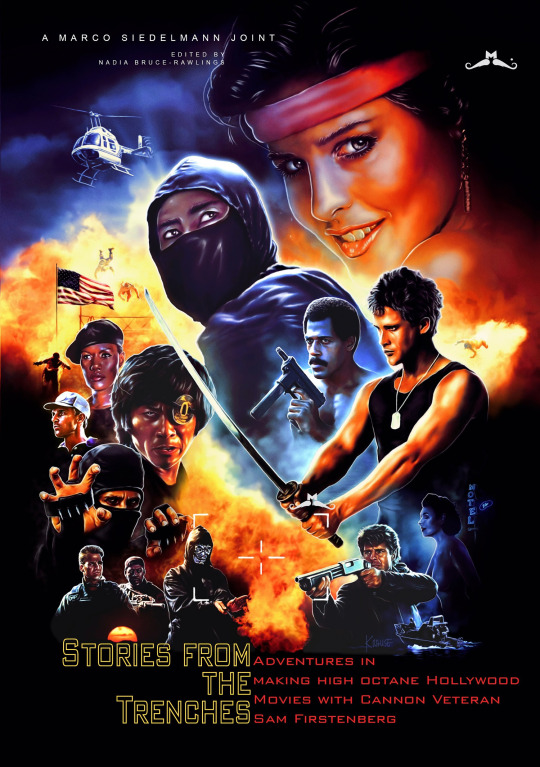
If Electric Boogaloo: The Wild, Untold Story of Cannon Films - Mark Hartley's excellent 2014 documentary on the independent film company - left you wanting more insight into Cannon Films' glory days, look no further than Stories from the Trenches: Adventures in Making High Octane Hollywood Movies with Cannon Veteran Sam Firstenberg. The book features firsthand accounts from filmmaker Sam Firstenberg and many of his collaborators. One of Cannon Films’ in-house directors during its 1980s heyday, Firstenberg helmed such cult classics as American Ninja, Breakin’ 2: Electric Boogaloo, Revenge of the Ninja, and Ninja III: The Domination.
The exhaustive read consists of a series of career-spanning conversations between the 70-year-old filmmaker and writer Marco Siedelmann over the course of 755 pages, along with anecdotal asides, interviews with his cast and crew (most of which are new, although some archival pieces are peppered in), and a plethora of black-and-white photos. Rather reworking the interviews into a narrative, the questions and answers are printed verbatim. It's segmented into seven chronological chapters, each of which is further broken down by film. The massive tome is coffee table book-sized but paperback.

The book kicks off with an introduction by Firstenberg, in which he explains how he came up with the title of Stories from the Trenches when he was considering writing his own memoir and what it means to him. He also sets the stage with a humorously stark contrast between his low-budget B-movies and their high-profile Hollywood brethren. It's followed by an introduction from film critic Oliver Nöding, who warmly explains why, as a teenager, he thought Cannon Films was the best studio in the world and Firstenberg was their standout director.
The first chapter, "The Early Years," explores Firstenberg's upbringing in Jerusalem, formative exposures to cinema, film school experience, working his way up the hierarchy as an assistant director (under Empire Films' Charles Band and Cannon Films' Menahem Golan, among others), and making his feature directorial debut on One More Chance in 1983. It also features interviews with assistant director Leo Zisman (Jane the Virgin), production manager Omri Maron (Iron Eagle), and producer David Womark (Life of Pi).

Stories from the Trenches really picks up, as does Firstenberg's career, in the second chapter, "King of the Sequels." The filmmaker opens up about his next three films - 1983's Revenge of the Ninja, 1984's Ninja III: The Domination, and 1984's Breakin’ 2: Electric Boogaloo - which happen to be among his most well-known works. He breaks down key scenes in each movie and discusses his relationship with Cannon Films.
This chapter is accompanied by interviews with stunt performer Steven Lambert (Titanic), editor Ken Bornstein (America's Next Top Model), karate champion Keith Vitali (Wheels on Meals), actor Jordan Bennett (Ninja III), producer Alan Amiel (The Blackout), cinematographer Hanania Baer (Masters of the Universe), and Breakin' cast members Lucinda Dickey, Michael Chambers, and Adolfo "Shabba-Doo" Quinones.
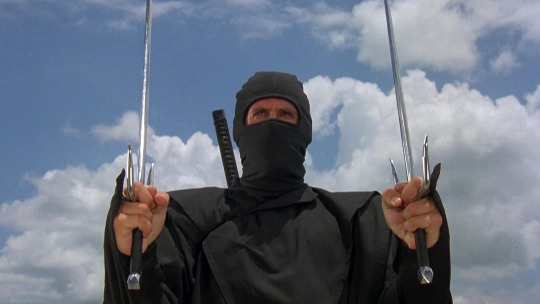
"The Golden Age of Cannon," is another interesting chapter. Set against the backdrop of the rising home video market, Firstenberg finds his voice as an action director on 1985's American Ninja before going on to make 1986's Avenging Force, 1987's American Ninja 2: The Confrontation, and 1989's Riverbend, the latter of which he made after his falling out with Cannon.
It includes interviews with producer Gideon Amir (Doom Patrol), writer Paul De Mielche (American Ninja), actress Judie Aronson (Friday the 13th: The Final Chapter), actor Michael Dudikoff (American Ninja), marshal artist Tadashi Yamashita (American Ninja), actor Steve James (To Live and Die in L.A.), actor Larry Poindexter (The Hard Times of RJ Berger), cinematographer Gideon Porath (Death Wish 4: The Crackdown), stunt performer BJ Davis (Army of Darkness), editor Michael J. Duthie (Stargare), and editor Marcus Manton (Pumpkinhead).

"Back in Israel" chronicles Firstenberg's journey of making films in Israel, including his only Hebrew film, 1990's The Day We Met; 1991's Delta Force 3: The Killing Game, after he rejoined the Cannon fold under its new regime; 1992's American Samurai, which was reworked by Cannon after he completed production; and Tropical Heat, a TV series on which he helmed six episodes in 1992. Editor Shlomo Hazan (American Samurai) is also interviewed.
"The Rise of Nu Image" covers Firstenberg being poached by Nu Image, whose low-budget action movie model was a spiritual successor to Cannon Films. His output during this era included the new film studio's second production, 1993's Cyborg Cop; its 1994 sequel, Cyborg Cop II, also known as Cyborg Soldier; 1993's Blood Warriors, produced by Indonesia's Rapi Films; and 1997's franchise-launching Operation Delta Force. Writer Jon Stevens Alon (Cyber Cop II) is also interviewed.

"The Late Years" sees Firstenberg working on his 1997 neo-noir thriller Motel Blue; the 1998 Hulk Hogan vehicle McCinsey's Island; 2000's The Alternate, also known as Agent of Death, on which the director returned to his action B-movie roots; directing second unit on Tobe Hooper's 2000 film, Crocodile; 2001's Spiders II: Breeding Ground, on which he implemented early CGI; and 2002's Quicksand. Curiously, 2001's Criss Cross is Firstenberg's only film to not receive its own section.
This chapter is accompanied by interviews with producer Frank DeMartini (Mechanic: Resurrection), actor Bryan Genesse (Operation Delta Force 3: Clear Target), visual effects artist-turned-writer Stephen David Brooks (The Mangler), and actress Brooke Theiss (A Nightmare on Elm Street 4: The Dream Master).

The epilogue covers Firstenberg's final film, The Interplanetary Surplus Male and Amazon Women of Outer Space, a hard-to-find 2003 send-up to campy sci-fi films from the '50s. It also includes a retrospective interview with the filmmaker from 2012. Israli filmmaker Alon Newman provides a brief afterword, noting Firstenberg's inspiration on his work.
Stories from the Trenches provides a fascinating look at a renegade style of filmmaking that only could have thrived in the 1980s. Firstenberg's story is a compelling one, even for cinephiles who may be unfamiliar with his oeuvre. Beyond minor grammatical errors, the book could have used a more scrupulous editor to trim the fat (including some of the dozens of photo pages laden with empty space) and tell a more concise, focused account without sacrificing the comprehensive nature; but presenting the conversations is full allows the reader to experience the story straight from the horse's mouth. I would love to see Siedelmann tackle the storied careers of other cult filmmakers who don't receive their due recognition.
Stories from the Trenches: Adventures in Making High Octane Hollywood Movies with Cannon Veteran Sam Firstenberg is available now via Editions Moustache.
#sam firstenberg#cannon films#american ninja#revenge of the ninja#breakin 2#breakin' 2: electric boogaloo#book#review#article#gift#ninja iii#ninja iii: the domination#ninja 3#80s movies#1980s movies
17 notes
·
View notes
Photo

⠀ In the mid 19th century, Frederic Church was one of America’s wealthiest artists. He belonged to the second generation of the Hudson River School, an art movement created by Thomas Cole, Asher B. Durand, and other landscape painters who worked around Newburgh. Church and his wife Isabel purchased an old farm across the river from Cole’s studio in 1860.⠀ ⠀ Their first two children on the farm died of diptheria, but at the close of the Civil War, they had four more. The family traveled to the Holy Land, and visited Syria, Lebanon, and Jerusalem. Victorian pilgrimages to the Holy Land during this time were quite common, immortalized in Herman Melville’s epic poem Clarel (1876). The West had been obsessed with Orientalism since the 18th century, a fascination with cultures from the “Orient,” which stretched from Greece and Northern Africa to Japan. Church treated these regions with great respect. ⠀ ⠀ Returning from his travels in 1869, he began sketching plans for a larger house, and purchased land on a massive hill above the farm. Church enlisted the help of Calvert Vaux to build a house reflecting Persian aesthetics and architectural features. The dramatic mansard roof tower with colored slate designs might have been an onion dome. During the planning process, Church adapted the shape, texture, and form of the house many times; his sketches still survive. ⠀ ⠀ When Vaux came to Newburgh to join A. J. Downing in 1851, they referred to these distinctive arches as being of a “Moorish” or “Saracenic” character, but they’re more appropriately Persian or Islamic. These arches are four-centered, curving smoothly into a point. In a Gothic Revival context, these could also be interpreted as Tudor. The double meaning makes the building appear worldly, appropriate for a well-traveled and educated man. ⠀ ⠀ ⠀ (at Olana, The Frederic Church Estate) https://www.instagram.com/p/CG0W4YRgZgc/?igshid=rszkjn4r6x2p
2 notes
·
View notes